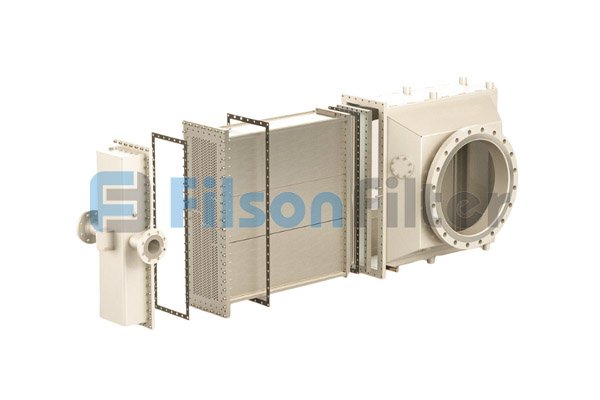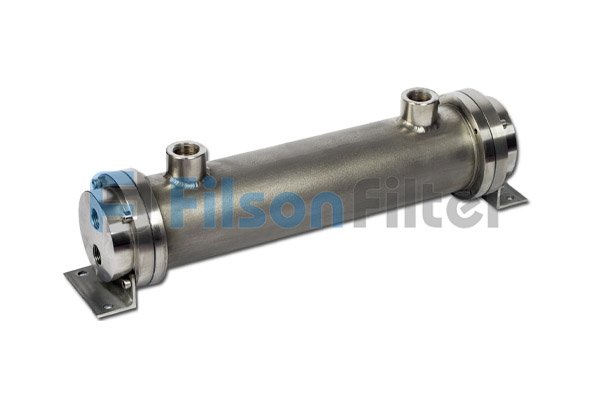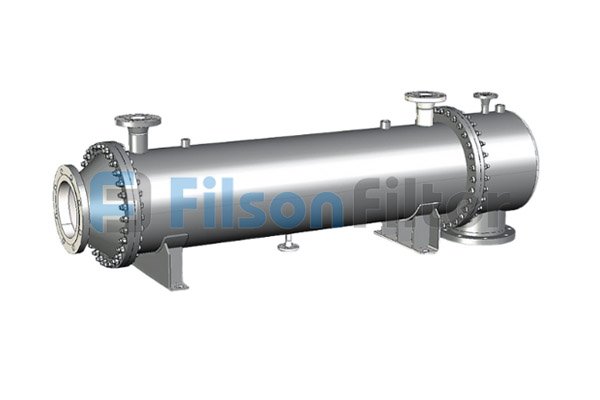Filson Gas Heat Exchanger
- Large heat transfer area
- Available to be designed into various standards
- Custom type to meet your specific requirements
- High temperature resistance
- Easy cleaning and maintenance
- Specifications
- Send Us Inquiry
Filson gas heat exchanger, also known as gas to gas heat exchanger or exhaust gas heat exchanger, is a heat transfer device applied to chemical processing, paper industry, petrochemical plants, power plants, etc.
- Material: stainless steel, carbon steel, metal alloys, nickel-based materials and more
- Media type: gas – gas
- Working temperature: under 450℃(up on material and type)
- Working pressure: up to 9.93MPa
- Heat transfer efficiency: 75-85%
- Heat exchange area: 1 – 800㎡
- Color: grey, blue, silver, brown(based on customer requirements)
- Standard: ASME, ANSI, JIS, GB
Send Your Inquiry Today
Filson Gas Heat Exchanger
Your Experienced Gas Heat Exchanger Manufacturer
Filson professional team has been studying heat exchanger for over 20 years. Now we possess the cutting edge technologies and advanced equipment in manufacturing all kinds of heat exchangers, and gas heat exchanger is one of the most popular products.
Typically, Filson gas heat exchanger adopts a shell and tube design to realize the exchange of heat. And It uses a counter or cross-flow inside the heat exchanger to improve the heat transfer efficiency.
Our customers are allowed to choose the size, installation position, material and other specifications from Filson. Usually, the size of a gas heat exchanger is determined by the heat exchange area you required.
Send us your questions and problems, our engineering sales will response within 8 working hours.
Gas Heat Exchanger: The Ultimate FAQ Guide
If you have any questions about gas heat exchanger, you will find the answer right here.
It covers everything including uses, benefits, limitations, efficiency and structural design, amongst others.
So, if you want to be an expert in the gas heat exchanger, read this guide.
- What is Gas Heat Exchanger?
- What are the uses of Gas Heat Exchanger?
- How do you Increase Efficiency in Exhaust Gas Heat Exchanger?
- What is the Working Principle of Furnace Heat Exchanger?
- What are the Benefits of Gas Heat Exchanger?
- What are the Limitations of Gas Heat Exchanger?
- How do you Specify Gas Heat Exchanger?
- How does Co-current, Counter-Current and Cross-Current in Heat Exchanger System for Gas compare?
- Can you use Shell and Tube Heat Exchanger for Industrial Gas Processing?
- How Efficient are Exhaust Gas Heat Exchangers?
- How do you Choose Thermo-plate Gas Heat Exchangers?
- What are the Industrial Applications of Gas to Gas Heat Exchangers?
- Why use Gas to Gas Heat Exchangers in Heat Recovery Systems?
- What is the Best Material for Gas to Gas Heat Exchanger?
- What is the Structural Design of Conventional Gas Heat Exchanger System?
- What Other Types of Heat Exchanger Systems are there?
What is Gas Heat Exchanger?
This heat exchanger facilitates the transfer of heat collected directly from the raw gas straight to the side of the device with clean gas.
It uses a counter/cross-flow heat exchanger.
Mostly, it takes the vertical design of a Shell and Tube Heat Exchanger.
Of course, it has some modifications to suit this purpose.
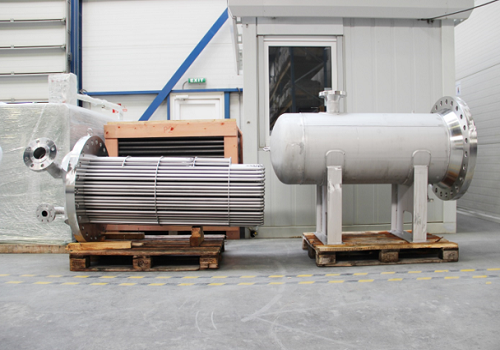
Gas heat exchanger
What are the uses of Gas Heat Exchanger?
This device helps increase the gas temperature in the various chemical processes.
It is used in the following applications:
- Industrial
- Environmental
- Food and beverage
- Pharmaceutical
How do you Increase Efficiency in Exhaust Gas Heat Exchanger?
You can increase the efficiency in this device by:
- Using a corrugation technology on the inside and outside of the walls of the device.
- Corrugation technology also helps minimize fouling
- Fitting expansion bellows to absorb/take up the differential expansion between the inner tubes and shell.
- Connecting multiple tubes via insulation, frame mounting, and stainless-steel cladding for larger application
- Using flanges as the standard connections for the device
- Using Matt as the finish material for internal and external surfaces
- Using stainless steel material for the construction of the device. However, you can use other suitable materials.
- Designing and constructing Exhaust gas heat exchangers that are in compliance with DOSH, ASME Code and European Union Vessel Directive.
What is the Working Principle of Furnace Heat Exchanger?
A Furnace Heat Exchanger helps keep the breathing air and combustion process separate.
This device prevents Carbon Monoxide poisoning.
It works by transferring the heat created in the combustion chamber to the unit’s exterior where it is blown via the ductwork all through the house.
It functions in three main steps:
The first step involves the combustion process where the furnace calls for heat.
The resulting combustion gases get into the chamber of the heat exchanger and heat up the metal walls.
Secondly, the return air ducts draw cold air from within the homes to blow along with the heat exchanger outside.
As the air blows along the heated walls of the heat exchanger, it gets warmer.
It is then sent back via the ducts to the different rooms of the home.
Using this mentioned process, breathing air and the combustion process remain separate.
Thirdly, the combustion process produces gases that are then blown out of the heat exchanger via a vent out of the home.
For a high-efficiency condensing furnace, gases move via a second heat exchanger that absorbs additional heat for use in the household.
What are the Benefits of Gas Heat Exchanger?
Below are some of the benefits of using a gas heat exchanger:
Safety
If used in a home, the device helps keep the occupants safe from any combustion byproducts.
Also, if the breathing air in the room were to mix with dangerous gases, then there could be a fatal disaster.
Easy Maintenance
The devices are structured in such a way that it is easy to clean the tubes, bundles and baffles without having to disassemble the whole system.
Besides, the cleaning fluids can easily reach every part of the device to remove any residues.
Cost
While the initial cost of this machine is high, the operation cost is low.
As such, they have a cost-effective operation.
The maintenance costs are also very low.
Low Fouling
Gas heat exchangers have low fouling.
Particles, or substances do not form residues in the device as it has a large surface area.
Also, the flow rate of the fluids used in the machine is high limiting deposits.
What are the Limitations of Gas Heat Exchanger?

Gas gas heat exchanger
Metal Fatigue
A Gas heat exchanger fails at some point in time.
It occurs due to the metal walls heating (expanding) and cooling (contracting).
Users should, therefore, prepare to replace their device at some point in life.
Wear and Tear
This device often suffers from wear and tear due to a number of factors.
A Gas heat exchanger should last around 10 and 20 years.
However, wear and tear are caused by factors such as maintenance, installation and design.
Some of the things to watch out for include:
- Improper maintenance
- Poor equipment design done by a manufacturer
- Bad installation and design
During a yearly HVAC maintenance on a Gas heat exchanger, you should conduct inspection for holes or cracks.
How do you Specify Gas Heat Exchanger?
When specifying heat exchanger system, you should consider the following:
- A Gas heat exchanger is designed to meet its intended application in regards to material selection.
Some of the materials include Hastelloy, carbon, stainless steel and highly
corrosion-resistant and heat-resistant steel.
- Transportation weight ranges from 1t – 150t
- The pressure difference is 400 mbar
- The operating pressure ranges from a minimum of -400 – 400 mbar
- The heat transfer surface is 400 m2 – 300,000 m2
- Thermal performance of 250 kW – 200 MW
- The device takes a space of around 1.5 m2 – 500 m2
- The height is around 1.5 – 20 m
- It can be used for applications with a volume flow of 5,000 m3/h – 2,500,000 m3/h
How does Co-current, Counter-Current and Cross-Current in Heat Exchanger System for Gas compare?
Co-current flow is often used to prevent temperature from falling below the due point.
This can be due to:
- Equal distribution of plate temperature
- Highest plate temperature
Cross-current flow is suitable for:
- Low to medium heat recovery rate
- Extremely high particle loading on one side
- Small to medium flow rate
- High operating temperatures
Counter-current flow arrangement is suitable for:
- Ultra-compact design
- Medium to large flow rates
- Maximum heat recovery of more than 90%
- Highest thermal efficiency
- Pure performance
Can you use Shell and Tube Heat Exchanger for Industrial Gas Processing?
Of course, yes.
You can use this device for industrial gas processing.
This process often involves compression and expansion stages that trigger thermal effects.
As such a need to cool or heat the gas using a heat exchanger.
Shell and tube heat exchangers enjoy some strengths in industrial gas processing.
They include excellent construction, design and hydraulic and thermal dimensioning.
How Efficient are Exhaust Gas Heat Exchangers?
Exhaust gas heat exchangers are very efficient devices.
They use waste heat from the exhaust of waste engine plants.
They are often located close to the plant’s engine.
This machine is usable in managing more than 90% of the efficiencies of the overall system.
The device’s design promotes the movement of thermal energy from the exhaust gas all through to the circulating hot water system.
This device is cladded and lagged to reduce noise emissions from the exhaust
The lagging also helps prevent heat from escaping from the exhaust
How do you Choose Thermo-plate Gas Heat Exchangers?
When selecting a Thermo-plate Gas Heat Exchanger consider the following factors:
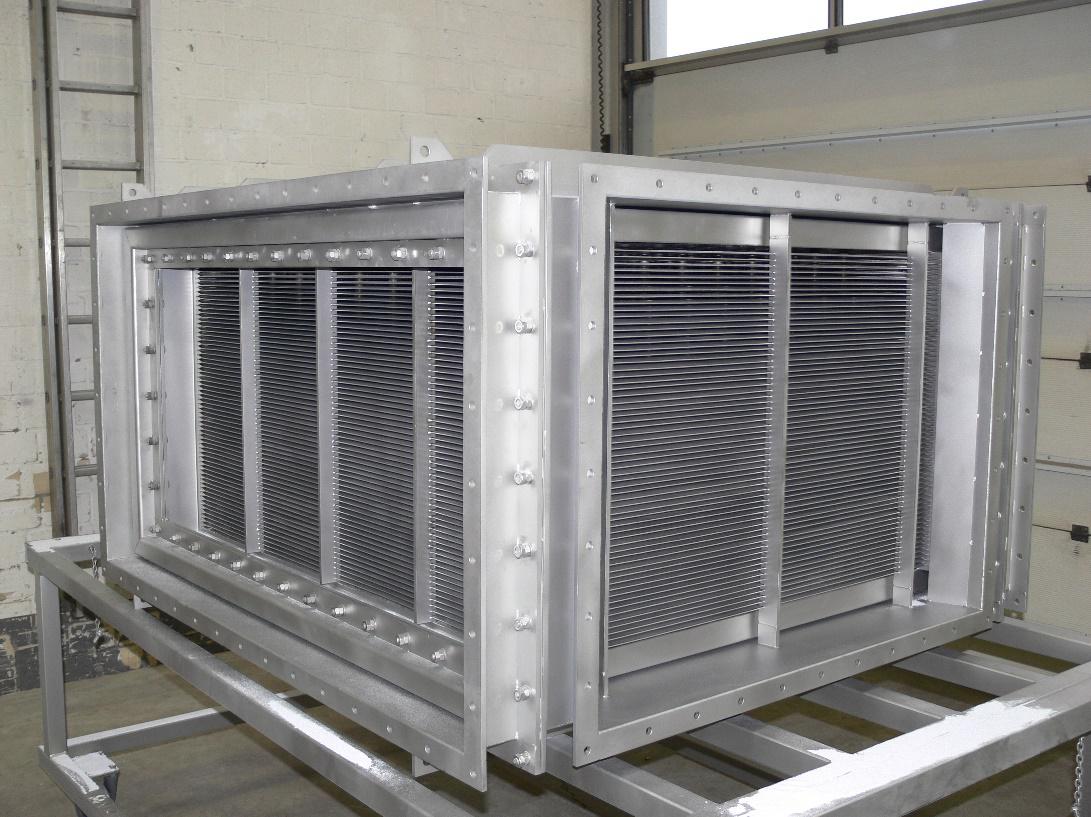
Gas heat exchanger
- Material of construction
- Maintenance ease
- Cost-effective operations
- Initial cost
- Utility space
- Low fouling
- Heat transfer design
- Optimized fluid flow
What are the Industrial Applications of Gas to Gas Heat Exchangers?
Gas to Gas Heat Exchangers have a large heat transfer surface: volume ratio at low pressure.
They come in cross, counter, and cross-flow formats.
Gas to gas heat exchanger provides cost-effective operation and flexibility.
This is because it can operate high temperature.
Due to these factors, this device is usable in the following industrial applications:
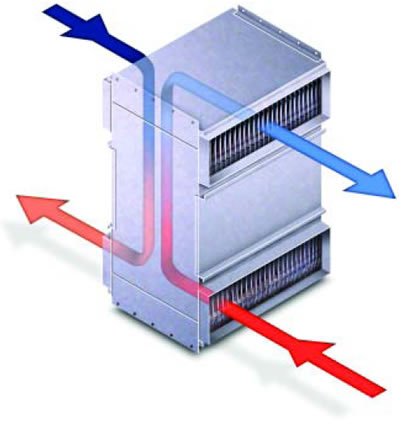
Gas to gas heat exchanger
- Chemical processing
- Paper industry
- Petrochemical plants
- Power stations
- Flue gas purification plants
Why use Gas to Gas Heat Exchangers in Heat Recovery Systems?
Some of the reasons why Gas Heat Exchangers are suitable for use in heat recovery systems are:
- They use individual solution for low volume heat installation condition
- Has low loss of pressure
- The fuel used in the system has a lower heating value
- It is highly effective
- Easy maintenance
- The boiler is efficient
- Self-cleaning effect
- They have a recuperator system
- Has an optimized fluid flow coupled with heat transfer design
- Low fouling
What is the Best Material for Gas to Gas Heat Exchanger?
To build a high-quality and safe Gas to Gas Heat Exchanger, you can use the following materials:
- Carbon Steel
- Stainless Steel
- Metal Alloys
- Nickel-based materials
What is the Structural Design of Conventional Gas Heat Exchanger System?
A conventional gas heat exchanger system helps transfer heat from one process to the other.
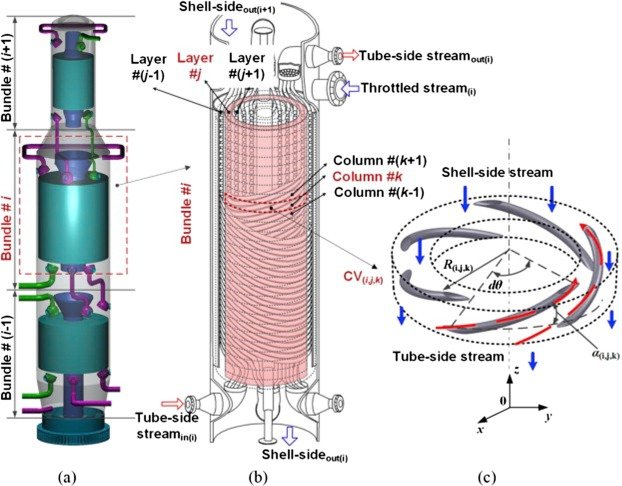
Cryogenic heat exchanger
This system is designed in such a way that it has a vertical configuration.
In addition, there are single segmental baffles.
The single segmental baffles build dead zones located on the flow path’s shell side.
Also, the nozzle configurations are limited because of single segmental baffles.
As such, the gas getting in the device’s shell side invades the tube bundle’s side.
The heat exchanger system has a cross-flow arrangement which induces high thermal stresses.
The device has large tube bundles.
These components make it difficult to gain a homogenous flow on the shell and tube side of the machine.
To gain permissible heat transfer coefficients, there must be a high-pressure drop on the shell side of the device.
On the shell side of the device, there are non-symmetrical and non-uniform profiles on temperature.
That said, when this machine has a single segmental baffle, gas is likely to move from over the tube bundle then aligned to the device’s tubes.
Then, the fluid moves to the following baffle making the gas to flow right back to the tubes.
It is very hard to design this machine because it has varied flow patterns that occur especially on the device’s shell side.
In addition, it is hard making predictions of the coefficients of the heat transfer.
There can be limitations such as tube-to-tubesheet joint failures and tubesheet warpages.
They occur due to temperature profiles that are non-uniform.
They occur over the tube bundle which contributes to energy/temperature stresses.
You can however include a double segmental baffle instead of a single segmental baffle.
You introduce gas directly to the two bundles specifically at two places at 1800 apart.
Gas moves over the tube straight to the tube bundle’s center via two baffles.
There is a space between the center of the tube bundles and the baffles.
This enables gas to move in the course of the tubes direct to the following section of the baffle.
One baffle positioned in tube bundle’s centre position redirects the gas to the tube bundle and to the shell.
This flow pattern continues until a desired thermal characteristic is achieved.
Advantages of double segmental baffles
- Flow is divided into two within the tube bundle as such, approximately half the total amount of gas crosses over the bundle.
There will be a pressure drop lower than the single segmental baffle. The other things however remain equal.
- They need large bundles to diffuse the gas to places 1800 separate on the shell.
- The shell side of the device is often larger in size to minimize overall pressure drop and house all tubes within the overlap of the baffles.
Improvements that come with double segmental baffles:
- The outlet and inlet have to be in sync with one another even if the flexibility of the shell side nozzle placement improves.
- There is a no-tube in window design eliminating all tubes inside the baffle window.
Gas movement occurs across the tube bundle making a prediction of the shell side heat transfer coefficients easier.
What Other Types of Heat Exchanger Systems are there?
There are several types of Heat Exchanger Systems used in a wide range of processes.
· Liquid-Air Heat Exchanger Pump Systems
This heat exchanger system removes heat at fluid temperature often above ambient temperature.
It has integrated fans, tank, a pump and a chassis.
· Liquid-Liquid Heat Exchanger Pump Systems
This cooling system gives accurate process of water temperature control.
The device then relays the heat from the waste to plant water through a liquid-to-liquid heat exchanger.
· Air-To-Water Cabinet Coolers
This heat exchanger system removes waste heat from enclosures and sealed electrical panels to below ambient temperature.
It functions depending on the temperature of the water supply
With this information, you can certainly choose a suitable gas heat exchanger for your applications.
However, in case you have any question, feel free to contact FilSon Filters team.
